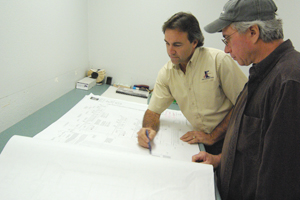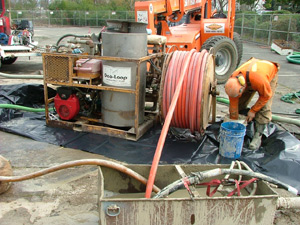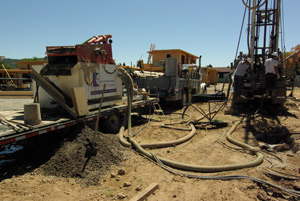 For residential projects, Air Connection typically designs the entire geoexchange mechanical system.
For residential projects, Air Connection typically designs the entire geoexchange mechanical system.
We do our best to integrate the equipment and delivery system in a way that honors the architectural integrity of the building. For commercial projects, we usually work directly with the project engineer and architect in the system design.
 Washington, DC-Imagine an HVAC system that could save clients 25 to 50 percent on their utility bills. Imagine a system that is not only easy to maintain and reliable, but for every hour of use, produces one pound less CO2 than a conventional HVAC system. Finally, imagine a system with optimal design flexibility because the roof and landscape are free of chillers, air handlers and other outdoor equipment.
Washington, DC-Imagine an HVAC system that could save clients 25 to 50 percent on their utility bills. Imagine a system that is not only easy to maintain and reliable, but for every hour of use, produces one pound less CO2 than a conventional HVAC system. Finally, imagine a system with optimal design flexibility because the roof and landscape are free of chillers, air handlers and other outdoor equipment.
Sound too good to be true? It isn't. Such a heating and cooling system exists and it is called geoexchange. Geoexchange utilizes natural thermal energy stored in the ground, minimizing the need to burn fuels to create new energy. Geoexchange requires far less energy and has much lower operating costs than traditional heating and cooling technologies.
And it's reliable. In fact, architect David Samokar of Clotfelter-Samokar in Lexington, Kentucky, believed so strongly in the technology that for one of his first installations he offered to replace the system free of charge if the client was not completely satisfied. "As it turned out, we never even had a discussion about replacement. It proved to be the best way for me to build the client's confidence in geoexchange, and it has paid off very well for my business," says Samokar.
 The system works by attaching geothermal heat pumps to the ground through either a series of buried plastic pipes (closed loop) or water wells (open loop) often beneath parking lots or green areas. Closed loop systems circulate water or an environmentally safe antifreeze. The fluid absorbs heat from the ground during the winter and transfers it to the heat pumps inside the building. In the summer, the process is reversed with heat from the building being returned to the ground. Open loop systems operate on the same principle and can be installed where an adequate water supply is available.
The system works by attaching geothermal heat pumps to the ground through either a series of buried plastic pipes (closed loop) or water wells (open loop) often beneath parking lots or green areas. Closed loop systems circulate water or an environmentally safe antifreeze. The fluid absorbs heat from the ground during the winter and transfers it to the heat pumps inside the building. In the summer, the process is reversed with heat from the building being returned to the ground. Open loop systems operate on the same principle and can be installed where an adequate water supply is available.
For the architect, this system brings several benefits, including design flexibility, reliability and energy efficiency. Knowledge of and experience with the system can also be an effective marketing tool for the architectural firm.
 Geoexchange can benefit a building's design because there is no need for unsightly and noisy rooftop equipment, such as split systems and cooling towers. Without the necessity of rooftop equipment, the architect is free to experiment with alternative roof styles. Eliminating rooftop equipment also reduces the load-bearing requirements of the roof structure. The air distribution ducts can be reduced, allowing for higher ceilings or reduced construction costs.
Geoexchange can benefit a building's design because there is no need for unsightly and noisy rooftop equipment, such as split systems and cooling towers. Without the necessity of rooftop equipment, the architect is free to experiment with alternative roof styles. Eliminating rooftop equipment also reduces the load-bearing requirements of the roof structure. The air distribution ducts can be reduced, allowing for higher ceilings or reduced construction costs.
In addition, boiler rooms can be eliminated and the size of mechanical rooms can be reduced. Less mechanical space means more productive space and more design freedom.
Geoexchange is also ideal for renovating buildings of historical merit. Because geoexchange installations are so flexible, they are generally the easiest systems to incorporate into an historic building. One successful strategy is to use smaller heat pumps dispersed in closets, basements, and attics to provide space conditioning and ventilation with minimal ducting. Because the ground loop heat exchanger is completely invisible, there are no unsightly condensers on the roof or grounds.
Geoexchange systems also offer ease of maintenance. The elimination of outdoor or rooftop equipment means equipment is not exposed to the temperature extremes, dirt, and pollution of the harsh outdoor environment. For this reason, Geoexchange systems require less maintenance than conventional systems. Furthermore, Geoexchange systems retain their high efficiency over the years. Since units are protected from weather, equipment life is extended and cost of repairs due to vandalism is eliminated.
 Geoexchange systems absorb the clean renewable geothermal energy stored in the earth, near the surface. Temperatures just below the earth's surface consistently range from 45° to 75°F, depending on the latitude. Because the temperature remains relatively constant and close to indoor temperatures, the earth is an ideal source for heating and cooling both residential and commercial buildings, and is viable in all 50 states.
Geoexchange systems absorb the clean renewable geothermal energy stored in the earth, near the surface. Temperatures just below the earth's surface consistently range from 45° to 75°F, depending on the latitude. Because the temperature remains relatively constant and close to indoor temperatures, the earth is an ideal source for heating and cooling both residential and commercial buildings, and is viable in all 50 states.
Geoexchange systems create and maintain a heat exchange between the earth and the building. In winter, they absorb heat from the earth, concentrate it via a heat pump, and transfer the warmth to the building's interior. In summer, they reverse the operation, removing heat from the building and transferring it to the cooler earth. Because the systems transfer heat to and from the stable and relatively moderate temperatures of the ground, they are more energy-efficient than other systems. This translates into lower energy bills and a reduction in the consumption of fossil fuels. For example, a geoexchange system typically saves 25 to 50 percent on heating and cooling bills, compared to other technologies.
 In 1992 when David Samokar first recommended a geoexchange system for a new school, the idea was so novel that the Kentucky Board of Education refused to have the system installed unless there was also a back-up HVAC system. This made the idea cost-prohibitive. That's when Samokar offered to replace the geoexchange system with conventional HVAC at no cost if the local school board was not satisfied. He backed this proposal up with a $200,000 bond.
In 1992 when David Samokar first recommended a geoexchange system for a new school, the idea was so novel that the Kentucky Board of Education refused to have the system installed unless there was also a back-up HVAC system. This made the idea cost-prohibitive. That's when Samokar offered to replace the geoexchange system with conventional HVAC at no cost if the local school board was not satisfied. He backed this proposal up with a $200,000 bond.
Samokar never had to install the conventional HVAC system and he's been installing geoexchange systems ever since. In fact, he has installed the systems at his home and office.
"The thing we like best about the system is that our customers have no problems with it. As the leader of a professional team on a building project, the architect receives all the complaints, and with geoexchange systems we've heard none," he says. In fact, Clotfelter-Samokar now specializes in the systems and recommends only geoexchange systems to all customers.
Samokar finds installation costs to be competitive with conventional systems. "People who don't understand the system tend to 'over-design' it, often making it cost-prohibitive. If you have a thorough knowledge of the system, you can design it in a cost-effective way."
Samokar says he is always surprised to hear of architects who leave the design of the heating and cooling system to the engineer. "We take control of the HVAC design, which in turn gives us more to offer our customers. With geoexchange growing increasingly popular in Kentucky, our knowledge and experience with the system has become a great marketing tool for our firm."
* Courtesy of IGSHPA (International Ground Source Heat Pump Association)